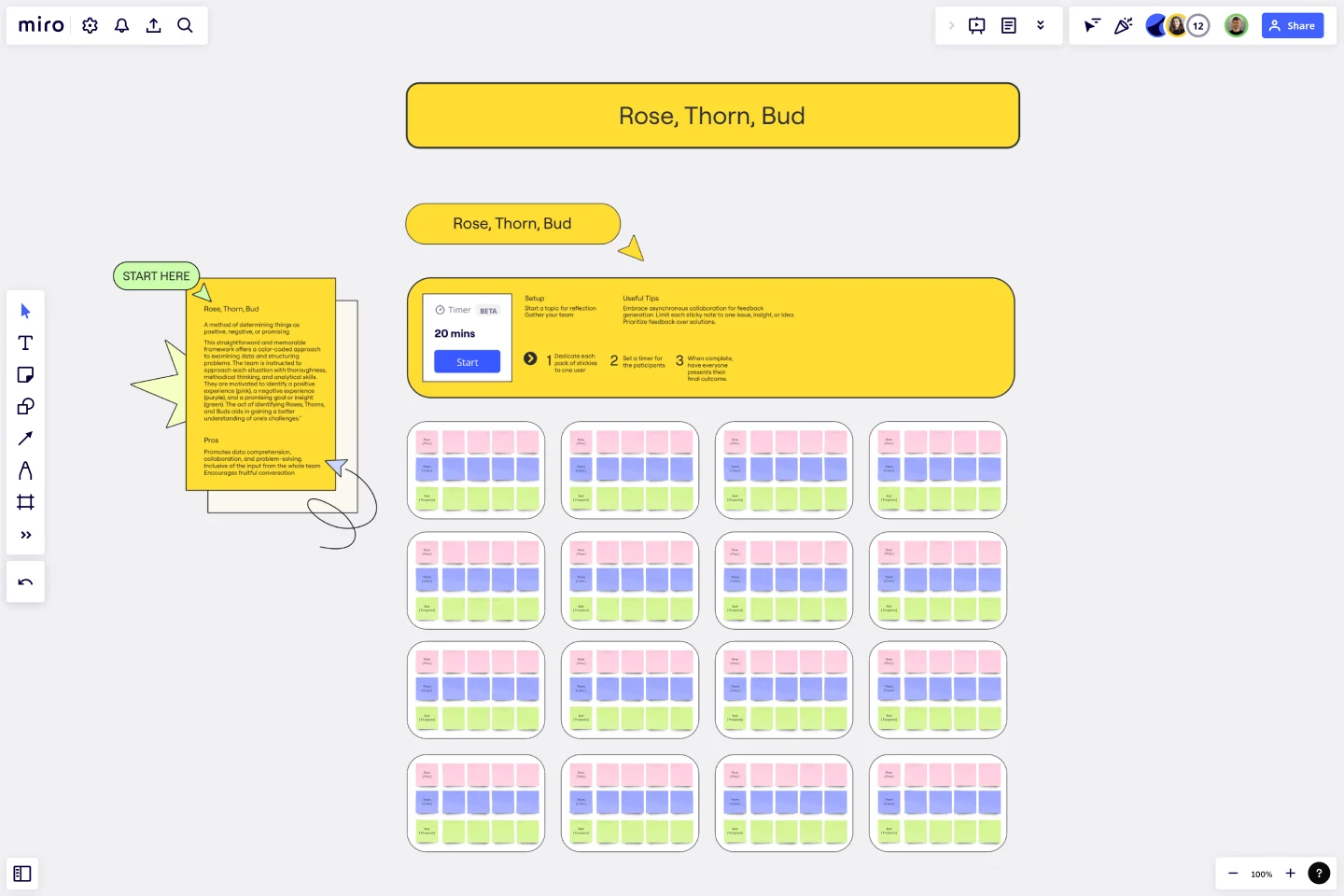Rose Thorn Bud Template
Categorize things as positive, negative, or promising with the Rose Thorn Bud Template.
About the Rose Thorn Bud Template
The Rose Thorn Bud Template provides a clear and comprehensive approach to analyzing data and structuring problems. The team is instructed to approach each situation with thoroughness, methodical thinking, and analytical skills. They are motivated to identify positive experiences (pink), negative experiences (purple), and promising goals or insights (green).
By using this framework, the team can better understand the challenges they face and develop effective strategies to overcome them. Identifying Roses, Thorns, and Buds encourages the team to think critically and creatively and approach problems with a positive and proactive mindset. This framework is valuable for any team looking to improve their problem-solving skills and achieve their goals.
Benefits of using the template
Promote data comprehension, collaboration, and problem-solving.
Inclusive of the input from the whole team.
Encourage fruitful conversation.
How to use the template in Miro
Dedicate each pack of stickies to one user.
Set a timer for the participants.
When complete, have everyone present their final outcome.
Setup
Start a topic for reflection.
Gather your team.
Useful tips
Embrace asynchronous collaboration for feedback generation.
Limit each sticky note to one issue, insight, or idea.
Prioritize feedback over solutions.
Get started with this template right now.
Journey Map To Plot the Customer Experience
Works best for:
Customer Journey Map
A journey is a tool to map out the customer experience of (a part of) your product/service in a visual way.
Creative Brief Template
Works best for:
Design, Marketing, Desk Research
Even creative thinkers (or maybe especially creative thinkers) need clear guidelines to push their ideas in productive, usable directions. And a good creative lays down those guidelines, with information that includes target audience, goals, timeline, and budget, as well as the scope and specifications of the project itself. The foundation of any marketing or advertising campaign, a creative brief is the first step in building websites, videos, ads, banners, and much more. The brief is generally prepared before kicking off a project, and this template will make it easy.
The Storyboarding Workshop Template
Works best for:
Storyboard, Design, Planning
Kick off your creative projects with the Storyboard Canvas template. This template is designed to help you map out your interactive video projects, providing a clear roadmap through branching scenarios. It's perfect for UX designers, marketers, and creative teams to visually organize and communicate the narrative flow. Use it to outline scenes, choices, and outcomes, ensuring every project element is accounted for and visually represented, making collaboration and brainstorming seamless.
iPhone App Template
Works best for:
UX Design, Desk Research, Wireframes
Incredible percentages of smartphone users worldwide have chosen iPhones (including some of your existing and potential customers), and those users simply love their apps. But designing and creating an iPhone app from scratch can be one seriously daunting, effort-intensive task. Not here — this template makes it easy. You’ll be able to customize designs, create interactive protocols, share with your collaborators, iterate as a team, and ultimately develop an iPhone app your customers will love.
Plant Care App Wireframe Template
Works best for:
Wireframe, UX, Design
The Plant Care App Wireframe template provides a multi-screen app wireframe along with all the necessary design pages to get started. You can easily customize the wireframe to meet the specific needs of your client or personal project. Add, remove, or adjust screens to create a smooth user flow, and personalize the design by modifying colors, typography, and layouts. Leverage our AI-powered features to further enhance your app design.
SUS Evaluation
Works best for:
Design, UX
To assess the emotional experience of users, use the SUS Evaluation Template. This involves conducting a survey with a set of questions where respondents rate their level of agreement on a scale ranging from 'Strongly Disagree' to 'Strongly Agree.' These questions evaluate various aspects of the user experience, such as ease of use, aesthetics, and overall satisfaction. This approach is valuable for comparing design iterations and evaluating the effectiveness of products and services.
